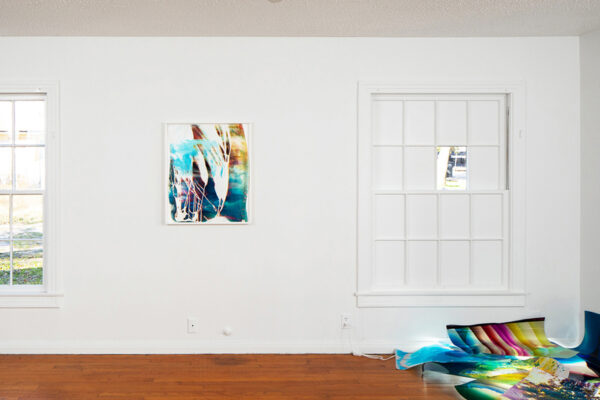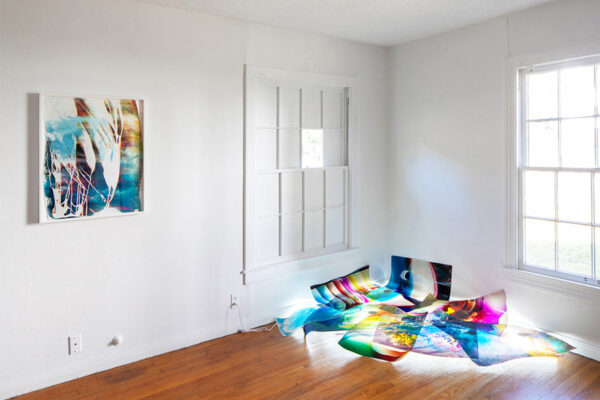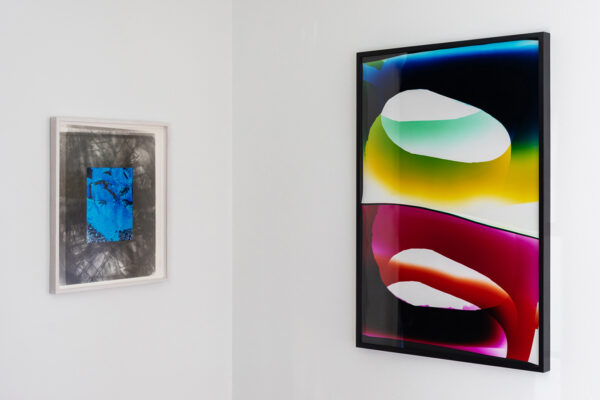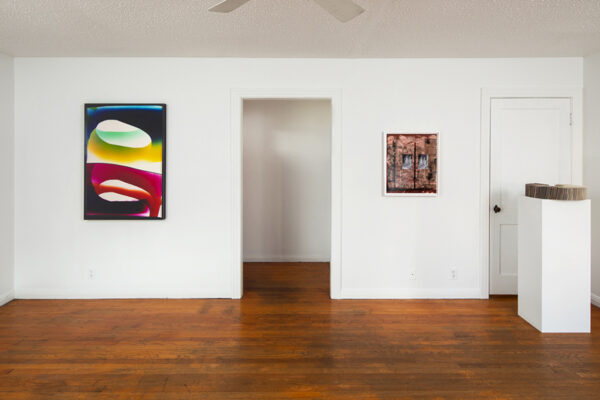
Installation view of work by Antonia Kuo and Mariah Robertson on view at F Gallery, Houston. Photo: © Sean Fleming.
Two New York-based Yale grads with years of mutual admiration between them were invited to share one space by F gallery’s Adam Marnie. The pairing makes sense: There’s a certain chemistry between Antonia Kuo and Mariah Robertson, and it’s deadly. Robertson has to wear a hazmat suit and a gas mask to produce her images, Kuo’s creative armor has a built-in vapor filter. The similarities do not end there. Both artists practice cameraless photography simultaneously, and sometimes in combination with landscapes and still lifes (Robertson also has some striking male nudes in her portfolio, but they are not on display here).
Still, when something recognizable ends up on their photographs, it’s not there to provide a reference for the abstract imagery, as is often the case with work that combines the figure and the shape. It’s there to point out the similar origin of both visions. Whether we look at traces of chemical compounds or a fragment of the earth’s crust, the images come into existence through similar manipulations with light and shadow. The chemical markings are no more and no less real than the impression left on film by an optical device.
While similar in method, their pictures are strikingly different in the effect they produce. A cursory glance at the titles reflects this. While Robertson’s naming of her work is akin to an archive of field recordings, with numbers corresponding to the sequence of the creation of the images, Kuo’s titles hint at cinematic narratives or directly reference existing films (Stalker, Body Snatcher). Visually, Robertson’s color is as tropical as it is chemical, the popping yellows, cyans, and purples glowing together in joyful anarchy. Her remarkable floor installation, Light Box #2 (2023), is as beautiful as an oil spill on a sunny day. It consists of color prints on the floor in a wavy formation with daylights underneath to enhance the glow even more. An earlier work, 340 (2015), reminds one of an abstract Gerhard Richter in its energy of expressive traces and disjointed shapes. 2022, 89 & 90 (2023) is almost serene in comparison, the oval forms resembling an Anthroposophic color chart.
Kuo employs a more restrained palette that takes one back to photography’s original color schemes — white, black, cyan, and sepia. Kuo’s work tends to ruffle in the eyes as it is composed of a myriad of fragments and elements that justify the frequent comparison to Jackson Pollock’s all-over paintings. There is more anxiety-inducing fragmentation in her images, and that’s by design: Kuo finds that photography is “something fundamentally voyeuristic and creepy.” The biggest piece, Swamp (2023), has originated in an unsettling encounter and looks either like a shattered stained-glass window or a blueprint for a ruin. Stalker (2023), a pair of gelatin silver prints depicting bear’s breeches attached to a brownish print that could be a prehistoric cave infested with ancient viruses, is the only work that hints at a filmic narrative, mostly thanks to its title, which makes one look for the titular offender in the foliage.
Once you get past the differences in emotional temperature, a new level of unity appears. Both Robertson and Kuo turn the viewer into an amateur archeologist (or criminologist) and make one question the exact nature of each line and color in their work. This cannot be done with a painting, where the layers are operationally of a piece, and the gesture is always only human. Robertson and Kuo share the stage with active elements of the Mendeleev’s table, and their work is full of intriguing occasions that limit their control of the outcome, while expanding the viewer’s engagement in sorting out the natural, the woman-made, and the industrial.
The artists successfully capture an exciting moment for photography as a field. Gone are the days of wonder, when practitioners and critics were searching for ways to question the medium’s veracity by employing historical research or turning light-sensitive paper into an object. Now any media image, published by any source, is subject to partisan interpretations and accusations of fakery. Kuo and Robertson turn this state of things around and make their photographs what they want them to be — that is, free and not susceptible to any bias.
Antonia Kuo and Mariah Robertson’s exhibition is on view at F in Houston through March 12, 2023.





